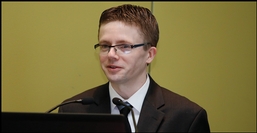Survey Shows Patients Prefer to Get Immediate Test Results
Wednesday, Nov. 29, 2017
For patients nervous about imaging exam results, would it help to get immediate results rather than making them wait for their next primary care visit or a notification by mail? And how onerous would it be for radiologists to be available for that service?
Those are the questions radiology resident David Mihal, MD, of the University of Cincinnati College of Medicine and the Cincinnati Children's Hospital (CCH) Medical Center sought to answer in research he conducted at Cincinnati Children's Hospital.

Mihal
As it turns out, even if patients ultimately decide to wait and get the results from their primary physician, they appreciate having the option of immediate notification, according to results presented by Dr. Mihal in a Tuesday session.
The pilot test conducted in the CCH Department of Radiology showed that radiologists appreciated having the option for immediate results as well, and did not feel inconvenienced by the extra few minutes it took to deliver the results.
Dr. Mihal began the study after learning that 20 percent of patients (or more often parents, because many of the patients were children) were uncertain about how they were going to get their results, and had expressed anxiety to the technologist doing the exam.
"They want to know, is it broken or not? Can he go back to soccer practice?" Dr. Mihal said. Technologists hesitated to bother busy radiologists with requests for immediate results.
The objectives of the study were to formalize a procedure for immediate reporting, to have at least 90 percent of patients be aware of the option, and to have at least 80 percent of patients satisfied with the option.
Technologists Survey Nervous Patients
The four-phase study, which initially included seven radiologists and 30 technologists, started by having techs screen outpatients to identify those who were nervous about their results or simply requested them. In the second phase, the front desk staff checked for patients who didn't have a follow-up appointment scheduled with another provider, and offered them the option of immediate results.
In the third phase, all radiography outpatients were offered immediate results as part of a questionnaire at check-in, though they were advised that getting the report would involve an extra 10 to 20 minutes of waiting. In the fourth phase, the wait-time notification was eliminated from the questionnaire. Patients also completed a follow-up survey about their reactions to having the immediate reporting option available. By the end of the study, 77 patients had completed the survey.
Each successive phase tripled the rate at which patients used the service. By the fourth phase, an average of one patient a day was asking to get results immediately, up from one patient a month in the first phase. Perhaps more important, 97 percent of patients understood that immediate results were available, and 92 percent of patient comments on the availability of the service were positive.
The additional burden on radiologists was negligible, and they reported being happy that they could deliver results to anxious patients.
"We feared having far more patients than we could possibly handle and potential interruptions in routine patient care, but that is not what happened," Dr. Mihal said. "Instead, patients were easily narrowed down to those who needed fast answers."
Dr. Mihal's work was awarded an RSNA Trainee Research Prize.
Does your #radiology department offer immediate results delivered directly to the patient by a radiologist? #RSNA17
— Radiological Society (@RSNA) November 28, 2017




 Home
Home Program
Program
 Exhibitors
Exhibitors My Meeting
My Meeting
 Digital Posters
Digital Posters Case of Day
Case of Day

